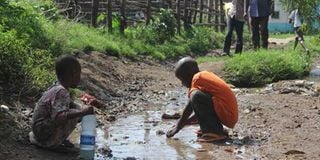Kenya spends Sh57bn to deal with ailments related to poor sanitation - Report

Children play in an open sewer in Homa Bay Town. A study by Japanese sanitation firm says every Kenyan spends at least Sh1,200 every year on ailments related to poor sanitation, translating to a total of Sh57.4 billion. FILE PHOTO | NATION MEDIA GROUP
What you need to know:
- The document titled ‘The True Cost of Poor Sanitation’ was compiled by Oxford Economics to determine the link between cost of sanitation and the factors behind it.
- But for a continent fraught with epidemics, the report by the Japanese firm paints a grim picture of sanitation on the continent.
- The report finds that five African countries are among the top 10 with the highest cost as a share of GDP.
- In East Africa, Ugandans spend Sh500 every year, just half what Rwandans spend in costs related to poor sanitation.
Every Kenyan spends at least Sh1,200 of their hard-earned money every year on ailments related to poor sanitation, translating to a total of Sh57.4 billion, a new report has revealed.
The study by Japanese sanitation firm LIXIL Group Corporation says soaring costs of keeping clean and healthy could be preventing developing countries like Kenya from channelling their monies to development projects.
The document titled ‘The True Cost of Poor Sanitation’ was compiled by Oxford Economics to determine the link between cost of sanitation and the factors behind it in 110 countries around the world.
The researchers split the costs in mortality, productivity, healthcare and access to facilities.
The report was launched Saturday as the Tokyo International Conference on African Development (Ticad VI) kicked off in Nairobi.
Japanese Prime Minister Shinzo Abe pledged a massive USD500 million to be channelled to African health systems through various global organisations like Global Fund, Gavi and others.
IMPROVE RESPONSE TO EMERGENCIES
The money, he said, will help African countries improve on responding to health emergencies, finance building of hospitals and other health facilities, in turn saving the lives of 300,000 people in the next three years.
But for a continent fraught with epidemics, the report by the Japanese firm paints a grim picture of sanitation on the continent.
Africa loses about 1 per cent ($19.3 billion) of its GDP due to poor sanitation.
This is almost the annual financial budget of Kenya.
In Kenya, the survey found that the country spends $574 million (Sh57.4 billion) to deal with sanitation problems.
More than two thirds (70 per cent) of this cost is felt because people die from water-borne diseases, where diarrhoea kills 3,100 children every year.
According to the World Health Organisation, about 13 per cent of Kenyans do not have toilets, and go to the bush for long calls.
Seventeen million Kenyans do not even have access to clean water, meaning they do not wash hands after going to the bush.
Yet the LIXIL Group Corporation says the findings can inspire innovations for toilets that can use less water.
INNOVATION IN SANITATION SYSTEMS
"There is a silver lining to the total lack of sanitation infrastructure in poor countries because innovators have the freedom to think big about what a genuinely excellent sanitation system would look like," said Ms Yu Yamakami, the deputy manager of the firm's Kenyan office.
"It isn't a matter of simply building sewers where they don't exist, because these aren't sustainable.
“Pit latrines and septic tanks are also not a solution because the waste removed from them is often simply transported elsewhere and left untreated," she added.
The company is currently trialling three types of toilets in Mukuru Kwa Njenga slums that, when approved, will be useful in areas where there is shortage of water to flush waste.
One of the designs, the green toilet, separates solid waste from urine. The solid waste is then mixed with saw dust and recycled to make manure.
In East Africa, Ugandans spend Sh500 every year, just half what Rwandans spend in costs related to poor sanitation.
The report finds that five African countries are among the top 10 with the highest cost as a share of GDP.
Niger, recently praised for having an appropriate budgetary allocation on health, spends 2.7 per cent of its GDP to deal with cleanliness problems.
Others are Sudan, (2.6 per cent), Eritrea (2.3 per cent), Senegal (1.7 per cent) and Central African Republic (1.7 per cent).
Given that most of these countries are poor, the researchers recommend that governments "should commit to a national strategy on sanitation to meet the sanitation target set out in the Sustainable Development Goals."





